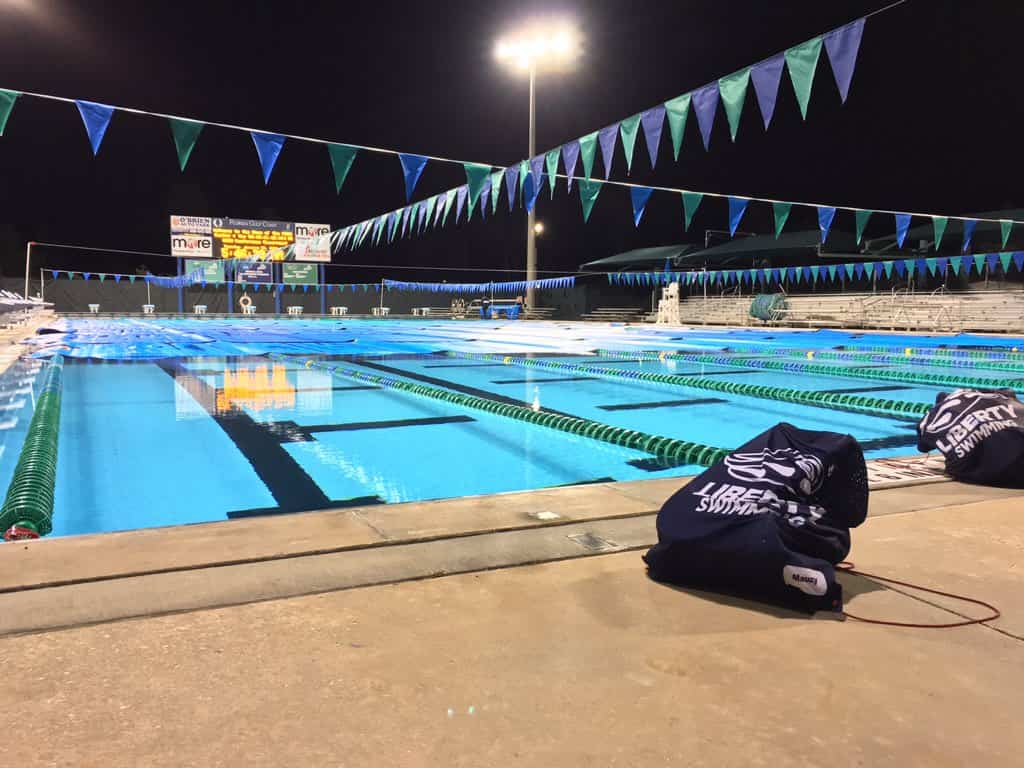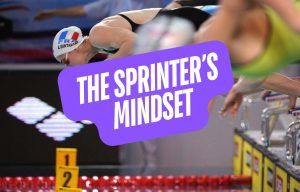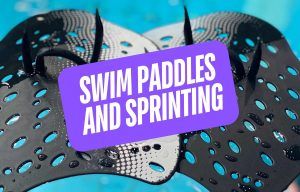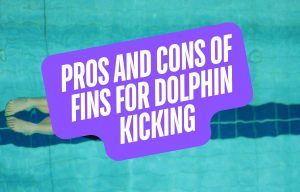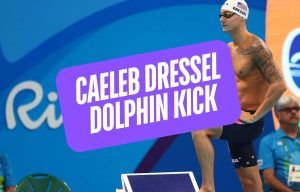This is a special guest post from Jake Shellenberger, head coach of NCAA division 1 program Liberty University. Jake is all about one thing–fast swimming! Here he drops one of his favorite drills for sprint freestylers that does a variety of things, from instilling better technical efficiency to developing power and brute strength. Enjoy!
The History of the Zona Drill
While writing a forthcoming, soon to be released in September book on power training for swimming, I received an email from Tom Meade, the masters coach at Binghamton University in New York. Tom heard about my book and wanted to share with me an article he wrote in 1976 for Swimming Technique magazine regarding an early Power Tower type device he invented called the “Swim-on.”
As a student of the sport and a lover of all things speed and power, I was delighted with his willingness to share a piece of swimming history, and read his article in earnest. Among many other great topics, to my surprise, was a major theme in Tom’s article regarding resistance and technique, specifically the idea that resistance training can be used to improve technique, and that coaches should see resistance as a tool to be used to aid in technical excellence, not a detriment to technical mastery as some today would want us to believe.
Again, it was 1976, and a graduate student was writing about the concept of using resistance to improve stroke technique. Today this is nothing new to those of us who coach speed for a living, as I would guess the majority of sprint coaches are using some form of resistance for drilling and technical mastery.
But for a student to embrace the topic in the late 70’s is something entirely different altogether. As it were, he emailed just as I was writing a chapter for the book on that very topic, drilling with resistance, and I included Tom’s thoughts in my writing. Yes, resistance can be used to develop technical mastery in the stroke, and I believe it is indeed one of the best ways to go about doing so.
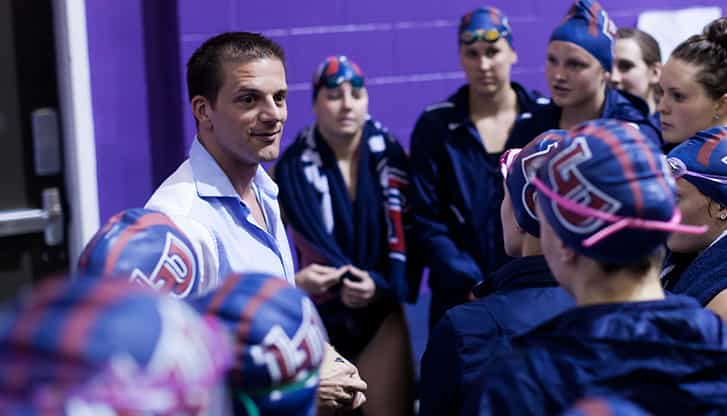
The drill I will share today is one that we often use here at Liberty and one that I share in the book as well. It has no unique name, we simply call it “Zona with Weight Belt,” and I believe it does much to improve technical excellence, strength, power, endurance, and core strength, depending on how the coaching staff chooses to prescribe it.
As for the Zona part of the name, I call it Zona in honor of the University of Arizona Swimming & Diving program, where I was fortunate to volunteer on deck with the Wildcats in the summer of 2007.
I was on staff full-time as the sprint coach at Penn State, but spent the long course season in Tucson in what we called a professional development or mentorship opportunity. Frank Busch was the head coach at Arizona the time, and was gracious enough to let me tag along; for that opportunity, I will always be grateful.
Again “Arizona Drill” is the name I gave it, some coaches know it simply as right swim paddle/left fin or something similar. Rick DeMont would have the sprint group at Arizona use this drill quite often, working on balance in the stroke and connecting the hands and feet diagonally through the core:
N X 50 with right fin and left paddle
N X 50 with left swim training fins and right paddle
N x 50 with fins and paddles
This freestyle drill, of course, is not unique to Arizona; you may know it under a different name and may already use it in your program. Rick would have the sprinters swim “Zona Style” on the Power Towers with resistance, and I took the concept back to Penn State in the fall of 2007 with great success. We continued to use “Zona Drill” with Power Towers during our first five years of program history here at Liberty, again with what I believe was a great success.
This past year at LU we experimented quite heavily with weight belts, borrowing from the beliefs of Cecil Colwin and Sam Freas. Freas, as many know, is credited with bringing weight belt training to the masses, as he has been a staunch proponent of swimming with weight belts for quite some time. Colwin, while not as well known, is also a believer in using weight belts in training, and spoke specifically about weight belts improving technique in his 2002 book “Breakthrough Swimming.”
Said Colwin of the belts:
As a coach, I discovered, quite by accident, that by wearing a weight belt most swimmers will automatically exert maximum leverage on the water and, in the process, find the stroke pattern best suited to his or her own body build or, to phrase it colloquially, his or her own individual set of levers.” (Colwin 2002, 47)
Thus, through my experience at Arizona and borrowing from the beliefs of Freas and Colwin, the drill “Zona with Weight Belt” was born. As we were already using Zona Drill with Power Towers, it seemed a natural progression to try it with weight belts, and we love the results after a year of experimentation.
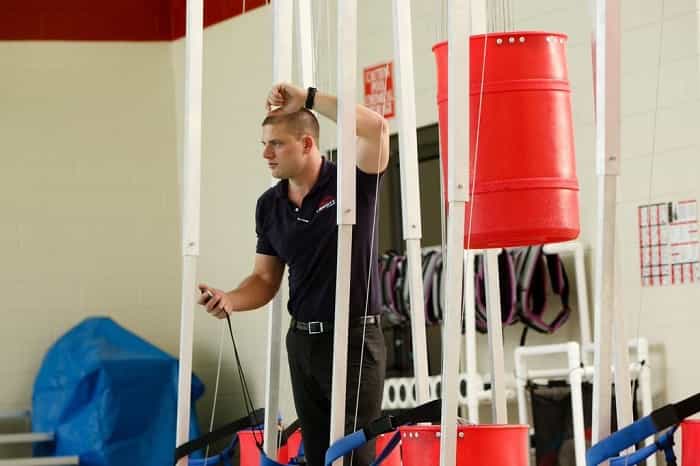
As an added benefit, as mentioned previously, this “drill” has many advantages depending on how it is prescribed. For example, it could be used as a lactate production power sprint set, a classic slow swimming, tech-focused drill set, or a race pace set as well.
We also use it in combination with the Power Towers for a Pure Power focused workout; this is quite an advanced technique, and I will touch on it just briefly in the example sets.
The Purpose of the Zona Drill
Again depending on the parameters prescribed by the coach (distance, load, interval, effort level, etc.), this drill has many benefits. Classic slow drilling with a light belt lends itself well to achieving the goals Colwin describes, as the brain learns where it can find maximum leverage on the water and the athletes can consciously think about connecting their hands to their feet from top to bottom and left to right.
A heavy belt, on the other hand, can be used to train brute strength and power; the athletes must maintain a high stroke and kick rate while engaging the core with all the effort they can summon to keep their hips high. It is rare to find a drill that works well with both maximum effort sprinting and resistance; sprinting with Zona Drill with weight belts is one of the best that I have discovered.
A few quick purpose/benefit points:
1. Core engagement and pier connectivity.
If we imagine the body as a bridge moving through the water, the feet and hands act as the piers that support the core, or span of the bridge. A weight belt loads the span, subsequently forcing the piers to “exert maximum leverage on the water” as Colwin states. This drill connects the piers through the span not only from top to bottom, but from left to right as well.
2. Develop overall total body strength, power, core strength, core power, core endurance, muscular endurance, etc.
This drill can do it all!
3. Increased technical excellence.
Again, to quote Colwin further:
Freestyle swimmers find that wearing a weight belt has a positive effect on their ability to place the stroke exactly where the strongest leverage results. The freestyle swimmer automatically adjusts the entry point of the hands to a position where he or she naturally feels the strongest resistance of water during the pull, even after the weight belt is removed.” (Colwin 2002, 47)
4. Novelty is rare in swimming, and drilling/sprinting Zona Style with weight belts is new and different for the brain and body. This is never a bad thing when coaching sprint types!
Focus Points
This drill demands 100% maximum effort from the athletes, even if using a light weight belt and performed in a slow, traditional manner.
What I mean by that is 100% maximum effort need not always be assumed purely physical; any drill, and especially Zona with Weight Belts, should be performed with 100% maximum effort focus from the brain. To achieve the objectives of the drill the athletes absolutely cannot let their hips sink, and this applies to sprinting, slow drilling, lactate tolerance work, power, etc..
Demand or ask for 100% focus from your athletes (dependent upon your coaching style) for this drill and accept nothing less.
A few focus points:
- The athletes must fully engage the core. Keep it tight!
- Neutral spine, level head, flat body. The hips will want to sink and the head will want to rise…keep them level.
- Focus on the legs as well, and be sure the athletes kick through any dead spots they might have in their stroke. Athletes will often pause the kick slightly on the recovery of one or both arms…kick!
- Engage the mind fully, with 100% focus, to find the “maximum leverage” on the water that Colwin describes, and then attempt to connect the fin and paddle diagonally through the core. Do not just assume this will happen with your athletes – encourage it through deliberate, focused practice and attention to detail.
- As per the above point, this applies to sprinting and power as well. It is much harder to focus 100% on small technical matters while sprinting, but those who can do so and do it well will have an advantage.
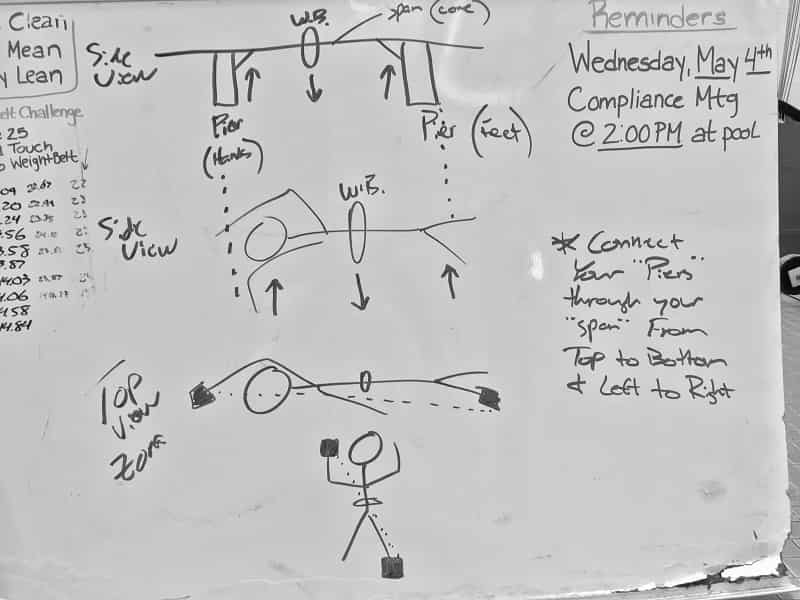
Above: My attempt at explaining Zona Drill with Weight Belts to our women. Thankfully I am a better swimming coach than an artist! The goal again is to connect the hands and feet through the core, from top to bottom and from left to right.
Example Sets
Classic slow swimming Zona with Weight Belt:
6 x 50 @ :50 With snorkel, left fin, right paddle, 6-pound weight belt
6 x 50 @ :50 With snorkel, right fin, left paddle, 6-pound weight belt
6 x 50 @ :50 With snorkel, both fins and paddles, 6-pound weight belt
The 6-pound weight belt is light for our women here at Liberty, though if a high school or club coach attempting this drill for the first time, I would obviously recommend you start even lighter. The focus is to connect the paddle to the fin, diagonally through the core, while maintaining the ideal stroke technique for the specific event/distance.
That is to say; a sprint athlete might try to hold a straight arm recovery with a deep, straighter arm pull, while a distance swimmer might work more on keeping the elbow at the surface on the pull and rotating the core with a classic hip-driven stroke.
The weight belt provides resistance in the downward, vertical direction, forcing the athletes to engage the core and swim with maximum leverage on the water as Colwin describes. The heavier the belt, the more important this leverage becomes, and we have women here at Liberty who can swim Zona Drill slowly, with a tech focus, with 16-pound weight belts; it is certainly a sight to see as they are maximizing every inch of the pull and every up and down beat of the kick.
Race Pace Zona with Weight Belt
This is an actual set we went this past spring with our sprint group, and it was an absolute joy to coach!
Three Rounds:
8 x 25 @ :40 Max, Zona style with Weight Belt, no snorkel
X-Tra: 20 seconds rest, weight belts off
1 x 50 Push Max, Zona Style, no snorkel
That is to say, on round one, for all efforts, the athletes would wear their left fin and right paddle. They would wear a weight belt for the 25’s. On round two they would wear their right fin and left paddle for all efforts, with a weight belt on for the 25’s. The last round would then feature greatness with both fins and paddles for all efforts with a weight belt for the 25’s.
Our best sprinter wore a 20-pound belt for this set, and it was quite impressive, to say the least. The 50 without the weight belt must be seen to be believed; it is as though the women are hydroplaning on the water and the efforts are FAST!
Pure Power Zona with Weight Belt
Three Rounds:
3 x 12.5 Max Blast Swim, Zona Style with heavy weight belt, no snorkel, no breath
1 x 15 Push Max, Zona Style, no weight belt, no snorkel, no breath
Again round one would be left paddle, right fin for all efforts, round two would be right paddle, left fin, and round three would be both fins and paddles. The 15’s Max with no weight belt are fun to watch, as the women receive a major Post-Activation Potentiation boost from the heavy belts prior.
I include an entire chapter in my book on “PAP” as it is referred to in the strength and conditioning world, and this sample set is just the tip of the iceberg with regards to how weight belts can be combined with sprint/power sets to elicit Post-Activation Potentiation in training.
Pure Power Zona with Weight Belts & Power Towers
Three Rounds:
3 x 12.5 Max Blast Swim, Zona Style with heavy weight belt, no snorkel, no breath, on the Power Tower with a heavy bucket dependent of course upon the strength, power, and experience level of the athlete
1 x 15 Push Max, Zona Style, no weight belt, no snorkel, no breath, no Power Tower
As this is the same set as above, again round one would be left paddle, right fin for all efforts, round two would be right paddle, left fin, and round three would be both fins and paddles.
Here we added the Power Tower to the mix, and now we have resistance acting not only vertically with the weight belt, but horizontally with the towers as well. If you are seeking the ultimate in Post-Activation Potentiation, this will get you close. The neuromuscular system is about as primed as is humanly possible to be after Zona Drill with heavy weight belts and Power Towers.
I should note: The above drill is quite advanced, and I would not attempt such efforts with high- school-aged athletes unless they already have experience with Power Towers, weight belts, and the weight room in general.
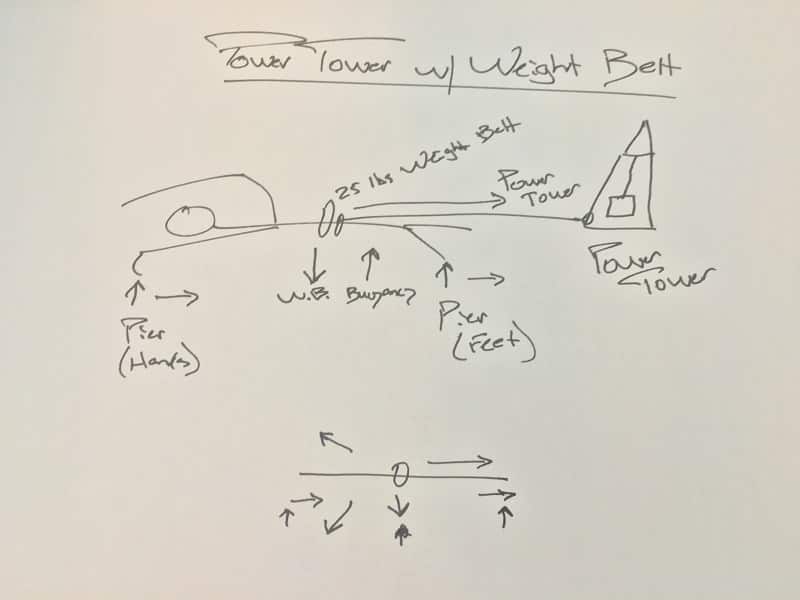
Above: A weight belt with a Power Tower presents quite the challenge for those coaches with a mind for physics. There are many forces that act upon the body when it moves through water with these loads. Note: The arrows from the piers represent both a lift and drag propulsive force. I did not include the frontal drag force of the body moving through the water, the drag force exerted by the flow of the water past the body, nor the surface drag created by the body and so forth. There are already too many arrows to think about!
In Closing
Weight Belts are a great training tool for swimmers and especially sprinters, and as Colwin stated, will force your athletes to find “maximum leverage on the water.” By adding the Zona Drill to the mix, we are not only training this leverage on the water, we are also adding diagonal pier connectivity through the core as well, and again this is a favorite drill for our sprint crew (and our entire team) here at Liberty. As an added benefit this drill is scalable, adaptable, and flexible; as per the examples above you could use this drill for Pure Power, slow tech-focused swimming, race pace, lactate production, and so on and so forth.
If you choose to implement this drill into your program, again be sure to start light and ask for 100% focus from your athletes, as allowing the hips to sag and the head to rise would defeat the purpose entirely; we certainly do not want to reinforce poor technical habits!
About The Author
A former assistant coach at Penn State and volunteer at the University of Arizona, Jake Shellenberger is currently the Head Swimming & Diving Coach at Liberty University in Lynchburg, VA, where he started the program from scratch in 2010. A two-time CCSA Coach of the Year, he also writes on a variety of topics in his spare time at www.jakeshell.com, and is the author of two books: “Letters to Chad: Building a Summer League Swim Team,” and a forthcoming book about power training for swimming to be released in September. You can catch up with Coach Shellenberger on Twitter as well.
References
Colwin, Cecil. 2002. Breakthrough Swimming. Champagne, IL: Human Kinetics.
More Stuff Like This:
7 Drills for Sprint Freestylers. Olympic coaches Mike Bottom and Brett Hawke share video of some of their favorite drills for freestylers.
3 Drills for a Faster Freestyle Kick. Freestylers, and sprinters in particular, need a big motor for legs. Here are three ways to mix up your training in the water to help build that devastating finishing kick.

